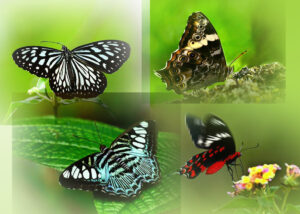Physical Address
23,24,25 & 26, 2nd Floor, Software Technology Park India, Opp: Garware Stadium,MIDC, Chikalthana, Aurangabad, Maharashtra – 431001 India
Physical Address
23,24,25 & 26, 2nd Floor, Software Technology Park India, Opp: Garware Stadium,MIDC, Chikalthana, Aurangabad, Maharashtra – 431001 India

The shades of fascinating colours and patterns make butterflies one of the most adored creatures, especially by nature lovers and open one’s eyes wide in appreciation of their intricate details and structure. Their beauty and ecosystem contributions should be appreciated in terms of their services.
Butterflies act as pollinators and play a significant role in the food chain by being a food source in all stages of their development to other organisms. Unfortunately, climate change has challenged the survival of these delicate creatures and has hampered their contribution to ecosystems.
We discussed this issue with butterfly expert Himesh Dilruwan Jayasinghe, a PhD candidate at the University of Colombo.
Butterflies are insects belonging to the order Lepidoptera, currently classified under the superfamily Papilionoidea. According to the national butterfly action plan, 248 butterfly species have been recorded from Sri Lanka. Of these, 31 are endemic species, while 86 are endemic subspecies. The level of endemicity, particularly at the subspecies level, is relatively high on our Island.
Most of the threatened butterflies in Sri Lanka are restricted to the wet climatic zones that harbour nearly all endemic butterflies. Many of the wet zone forests where these threatened endemic butterflies reside have been cleared for agriculture, and only 3% of the original forest cover remains intact. The continuous overexploitation of these forests has a very significant impact on the populations of butterflies. A similar process is likely to occur in the northern areas where the rapid expansion of economic activities has cleared vast forests for agriculture and urban development.
The long-term effects of climate change on butterflies are difficult to predict. There is evidence that the butterfly populations in the colder environments are restricted from moving to lower temperature gradients and will be most affected (e.g. Spindasis greeni). In addition, extreme weather conditions like increased droughts, heavy rains, and changed rainfall patterns and distribution impact butterfly populations. More can be read here
Butterfly expert Himesh Jayasinghe explains that butterfly populations typically increase with rainfall and decrease with droughts. Hence butterfly births are closely associated with rainfall patterns in Sri Lanka.
Sri Lanka receives rain from the Southwest monsoon, Northeast monsoon, and Inter-monsoons during the year. This leads to the hatching of butterfly eggs. On the other hand, monsoon rains help to sprout up plants and better growth until they become mature which in turn makes more feeding options for butterflies.
However, global warming, GHG emissions, and many other factors impact weather patterns, resulting in changing rainfall patterns. In the case of Sri Lanka, this means that the island receives several showers of rain in addition to the monsoon rains, which leads to the unusual hatching of butterfly eggs. Yet these rains are not sufficient for plant growth; therefore, a more number of butterflies are left with fewer places to lay their eggs. Consequently, the next generation of butterflies is lost. This is considerable damage caused by climate change to butterflies.
A recent study carried out by a group of researchers led by Erica Henry, a postdoc in applied ecology at NC State, shows how the shifting rainfall patterns have a significant effect on the butterflies.
During this study, the researchers simulated 20 different climate models to test how Miami blue butterfly (Cyclargus thomasi bethunebakeri) would respond to climate changes, and in most of the tests, the butterfly population had declined when the rainfall was delayed and the diapause duration (a period of physiologically enforced dormancy between periods of activity) increased.
Erica says that “We found that shifting rainfall patterns can determine whether the Miami blue butterfly populations grow or shrink, even without any other environmental variables changing” and added that it was not only related to the rare species of Miami blue butterfly but is applicable for all insects in precipitation-driven systems and that rainfall patterns have largely been neglected in the conservation activities related to climate change and animal lifecycles. More can be read here. archived.
Invasive plants are threatening the existence of larval food plants and nectar sources. Such displacements may also lead to the loss of obligatory associations with many Formicidae (ants) members, whose relationship with some Lycaenidaeise is well-known. Some invasive plants and their effects on particular butterfly species are mentioned below.
Butterfly expert Himesh Jayasinghe said that many invasive plants threaten butterflies by invading native vegetation. Most butterfly larvae in Sri Lanka feed on plants except for one species (Spalgis epeus). Additionally, Sri Lanka is home to 480 species of LFPs, feeding 207 butterfly species. They also need nectar, sapping, and fruiting plants to survive. More information can be gained here Archived.
There is a special sighting that Himesh described, “Butterflies are known to migrate with the monsoon rains. The albatross butterfly migrates at the end of the northeast monsoon. Therefore, Drypetes sepiaria leaves should be sprouting by the month of February. For that purpose, rain should be present in December as usual. But it is no secret that climate change has changed the timing of rains, adding significant threats to the future of butterfly populations.
Does climate change restrict butterfly migration? Look forward to the following article with pioneer butterfly researcher Rajika Gamage.
Comments are closed.
Great👍
Thank you for loads of valuable facts!